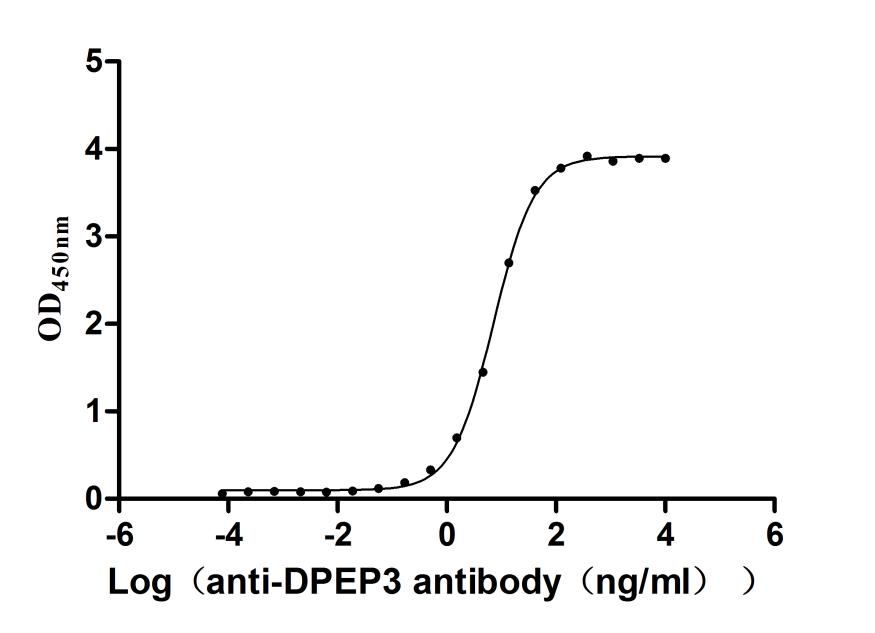Recombinant Human F-BAR and double SH3 domains protein 2 (FCHSD2)
-
货号:CSB-YP008549HU
-
规格:
-
来源:Yeast
-
其他:
-
货号:CSB-EP008549HU
-
规格:
-
来源:E.coli
-
其他:
-
货号:CSB-EP008549HU-B
-
规格:
-
来源:E.coli
-
共轭:Avi-tag Biotinylated
E. coli biotin ligase (BirA) is highly specific in covalently attaching biotin to the 15 amino acid AviTag peptide. This recombinant protein was biotinylated in vivo by AviTag-BirA technology, which method is BriA catalyzes amide linkage between the biotin and the specific lysine of the AviTag.
-
其他:
-
货号:CSB-BP008549HU
-
规格:
-
来源:Baculovirus
-
其他:
-
货号:CSB-MP008549HU
-
规格:
-
来源:Mammalian cell
-
其他:
产品详情
-
纯度:>85% (SDS-PAGE)
-
基因名:FCHSD2
-
Uniprot No.:
-
别名:FCHSD2; KIAA0769; SH3MD3F-BAR and double SH3 domains protein 2; Carom; Protein nervous wreck 1; NWK1; SH3 multiple domains protein 3
-
种属:Homo sapiens (Human)
-
蛋白长度:Full length protein
-
表达区域:1-740
-
氨基酸序列MQPPPRKVKV TQELKNIQVE QMTKLQAKHQ AECDLLEDMR TFSQKKAAIE REYAQGMQKL ASQYLKRDWP GVKADDRNDY RSMYPVWKSF LEGTMQVAQS RMNICENYKN FISEPARTVR SLKEQQLKRC VDQLTKIQTE LQETVKDLAK GKKKYFETEQ MAHAVREKAD IEAKSKLSLF QSRISLQKAS VKLKARRSEC NSKATHARND YLLTLAAANA HQDRYYQTDL VNIMKALDGN VYDHLKDYLI AFSRTELETC QAVQNTFQFL LENSSKVVRD YNLQLFLQEN AVFHKPQPFQ FQPCDSDTSR QLESETGTTE EHSLNKEARK WATRVAREHK NIVHQQRVLN DLECHGAAVS EQSRAELEQK IDEARENIRK AEIIKLKAEA RLDLLKQIGV SVDTWLKSAM NQVMEELENE RWARPPAVTS NGTLHSLNAD TEREEGEEFE DNMDVFDDSS SSPSGTLRNY PLTCKVVYSY KASQPDELTI EEHEVLEVIE DGDMEDWVKA RNKVGQVGYV PEKYLQFPTS NSLLSMLQSL AALDSRSHTS SNSTEAELVS GSLNGDASVC FVKALYDYEG QTDDELSFPE GAIIRILNKE NQDDDGFWEG EFNGRIGVFP SVLVEELSAS ENGDTPWMRE IQISPSPKPH ASLPPLPLYD QPPSSPYPSP DKRSSLYFPR SPSANEKSLH AESPGFSQAS RHTPETSYGK LRPVRAAPPP PTQNHRRPAE KIEDVEITLV
-
蛋白标签:Tag type will be determined during the manufacturing process.
The tag type will be determined during production process. If you have specified tag type, please tell us and we will develop the specified tag preferentially. -
产品提供形式:Lyophilized powder
Note: We will preferentially ship the format that we have in stock, however, if you have any special requirement for the format, please remark your requirement when placing the order, we will prepare according to your demand. -
复溶:We recommend that this vial be briefly centrifuged prior to opening to bring the contents to the bottom. Please reconstitute protein in deionized sterile water to a concentration of 0.1-1.0 mg/mL.We recommend to add 5-50% of glycerol (final concentration) and aliquot for long-term storage at -20℃/-80℃. Our default final concentration of glycerol is 50%. Customers could use it as reference.
-
储存条件:Store at -20°C/-80°C upon receipt, aliquoting is necessary for mutiple use. Avoid repeated freeze-thaw cycles.
-
保质期:The shelf life is related to many factors, storage state, buffer ingredients, storage temperature and the stability of the protein itself.
Generally, the shelf life of liquid form is 6 months at -20°C/-80°C. The shelf life of lyophilized form is 12 months at -20°C/-80°C. -
货期:Delivery time may differ from different purchasing way or location, please kindly consult your local distributors for specific delivery time.Note: All of our proteins are default shipped with normal blue ice packs, if you request to ship with dry ice, please communicate with us in advance and extra fees will be charged.
-
注意事项:Repeated freezing and thawing is not recommended. Store working aliquots at 4°C for up to one week.
-
Datasheet :Please contact us to get it.
相关产品
靶点详情
-
功能:Adapter protein that plays a role in endocytosis via clathrin-coated pits. Contributes to the internalization of cell surface receptors, such as integrin ITGB1 and transferrin receptor. Promotes endocytosis of EGFR in cancer cells, and thereby contributes to the down-regulation of EGFR signaling. Recruited to clathrin-coated pits during a mid-to-late stage of assembly, where it is required for normal progress from U-shaped intermediate stage pits to terminal, omega-shaped pits. Binds to membranes enriched in phosphatidylinositol 3,4-bisphosphate or phosphatidylinositol 3,4,5-trisphosphate. When bound to membranes, promotes actin polymerization via its interaction with WAS and/or WASL which leads to the activation of the Arp2/3 complex. Does not promote actin polymerisation in the absence of membranes.
-
基因功能参考文献:
- Loss of FCHSD2 activity in nonsmall cell lung cancer (NSCLC) cells leads to increased cell-surface expression and altered signaling downstream of EGFR, resulting in enhanced cell proliferation and migration. PMID: 30249660
- Established 3 models of Carom-receptor complexes and their intracellular trafficking based on protein interaction and subcellular localization. Carom may mediate receptor endocytosis and transport endocytic receptors to the cytoplasm for receptor signaling and lysosome/proteasome degradation. Review. PMID: 28199211
- A novel SNP-systemic lupus erythematosus association was identified between FCHSD2 and P2RY2, peaking at rs11235667 on a 33-kb haplotype upstream of ATG16L2. PMID: 26663301
- our study, for the first time, demonstrates FCHSD2 as a predictor of outcome for Acute myeloid leukemia patients PMID: 22902056
-
亚细胞定位:Cytoplasm. Cell junction. Membrane, clathrin-coated pit. Cell membrane; Peripheral membrane protein; Cytoplasmic side. Cell projection, stereocilium.
-
组织特异性:Liver, brain, heart, placenta, skeletal muscle, pancreas, lung and kidney.
-
数据库链接:
HGNC: 29114
OMIM: 617556
KEGG: hsa:9873
STRING: 9606.ENSP00000386722
UniGene: Hs.744959
Most popular with customers
-
Recombinant Human HLA class II histocompatibility antigen gamma chain (CD74), partial (Active)
Express system: Mammalian cell
Species: Homo sapiens (Human)
-
Recombinant Human Tumor-associated calcium signal transducer 2 (TACSTD2), partial (Active)
Express system: Mammalian cell
Species: Homo sapiens (Human)
-
Recombinant Human Carcinoembryonic antigen-related cell adhesion molecule 8(CEACAM8) (Active)
Express system: Mammalian cell
Species: Homo sapiens (Human)
-
Recombinant Human Dipeptidase 3(DPEP3), partial (Active)
Express system: Mammalian cell
Species: Homo sapiens (Human)
-
Recombinant Human C-C chemokine receptor type 5 (CCR5)-VLPs (Active)
Express system: Mammalian cell
Species: Homo sapiens (Human)


-AC1.jpg)














